课件专题十三反意疑问句祈使句感叹句以及其它特殊句式
- 格式:doc
- 大小:22.50 KB
- 文档页数:7
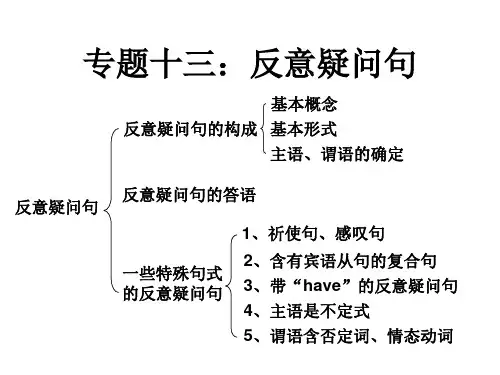
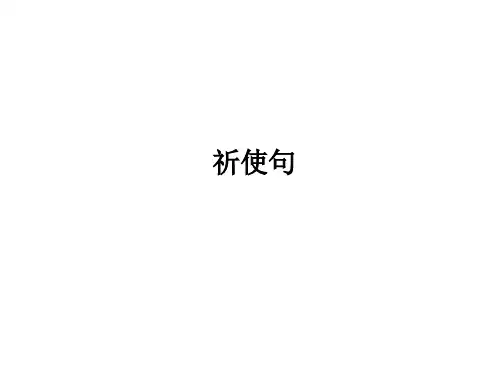
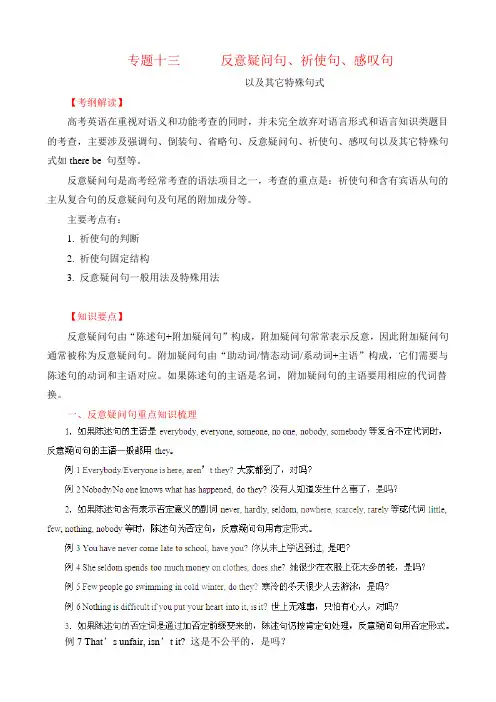
专题十三反意疑问句、祈使句、感叹句以及其它特殊句式【考纲解读】高考英语在重视对语义和功能考查的同时,并未完全放弃对语言形式和语言知识类题目的考查,主要涉及强调句、倒装句、省略句、反意疑问句、祈使句、感叹句以及其它特殊句式如there be 句型等。
反意疑问句是高考经常考查的语法项目之一,考查的重点是:祈使句和含有宾语从句的主从复合句的反意疑问句及句尾的附加成分等。
主要考点有:1. 祈使句的判断2. 祈使句固定结构3. 反意疑问句一般用法及特殊用法【知识要点】反意疑问句由“陈述句+附加疑问句”构成,附加疑问句常常表示反意,因此附加疑问句通常被称为反意疑问句。
附加疑问句由“助动词/情态动词/系动词+主语”构成,它们需要与陈述句的动词和主语对应。
如果陈述句的主语是名词,附加疑问句的主语要用相应的代词替换。
一、反意疑问句重点知识梳理例7 That’s unfair, isn’t it? 这是不公平的,是吗?例8 The meeting is unimportant, isn’t it? 这个会议不重要,对吗?4.如果陈述句是“I’m…”结构时,反意疑问句用aren’t I。
例9 I’m a good student, aren’t I? 我是一个好学生,对吗?例10 I’m going to attend your lecture, aren’t I? 我打算听你的讲座,好吗?5.如果陈述句是“There be”句型,反意疑问句也借助there。
例11 There is a tall tree in front of your house, isn’t there? 你家房前有一棵大树,是吗?例12 There used to be a bus stop near our school, usedn’t there/didn’t there? 我们学校附近曾经有一个汽车站,对吗?例13 There stands an old temple on the top of the mountain, doesn’t there? 山顶矗立着一座古庙,是吗?6.如果陈述句的主语是one,反意疑问句的主语在正式场合用one, 在非正式场合用you。

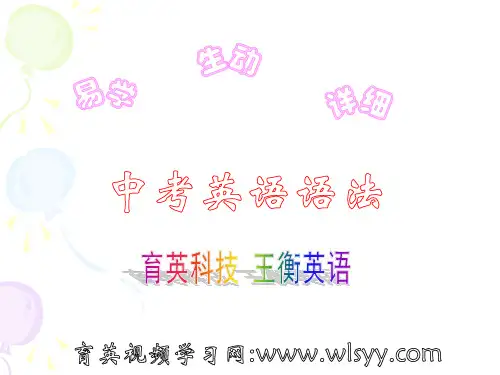
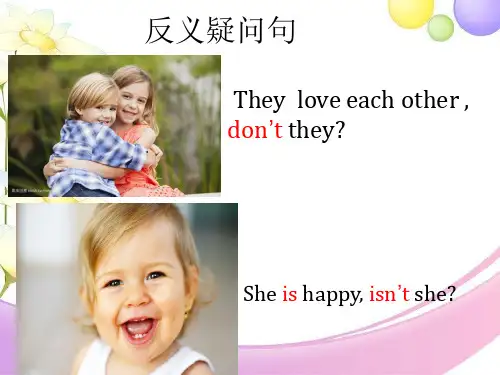
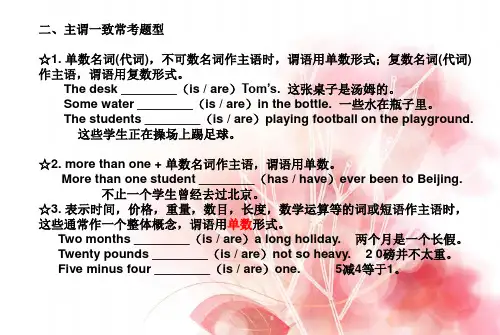
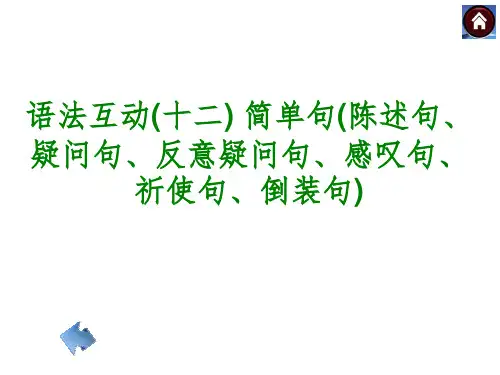

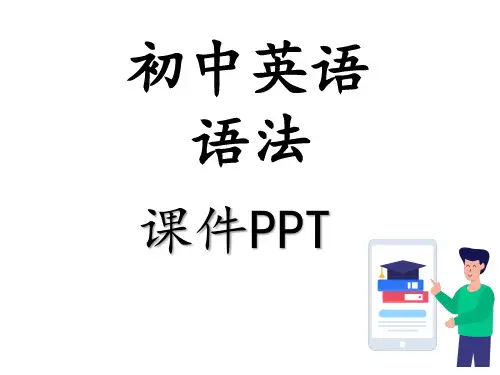
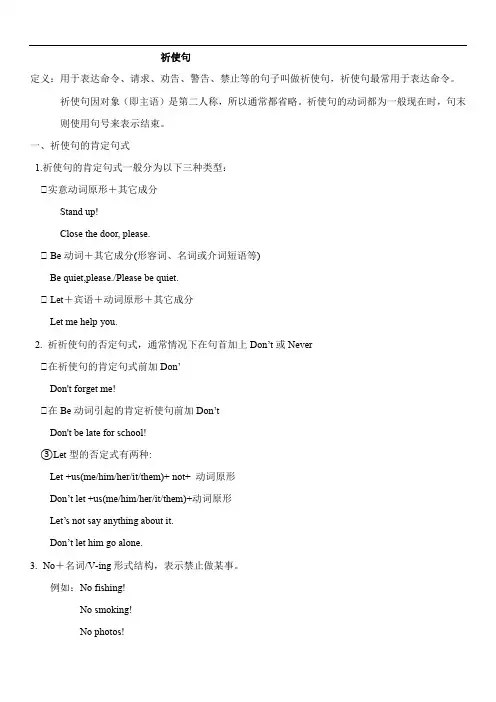
祈使句定义:用于表达命令、请求、劝告、警告、禁止等的句子叫做祈使句,祈使句最常用于表达命令。
祈使句因对象(即主语)是第二人称,所以通常都省略。
祈使句的动词都为一般现在时,句末则使用句号来表示结束。
一、祈使句的肯定句式1.祈使句的肯定句式一般分为以下三种类型:①实意动词原形+其它成分Stand up!Close the door, please.① Be动词+其它成分(形容词、名词或介词短语等)Be quiet,please./Please be quiet.① Let+宾语+动词原形+其它成分Let me help you.2. 祈祈使句的否定句式,通常情况下在句首加上Don’t或Never①在祈使句的肯定句式前加Don’Don't forget me!①在Be动词引起的肯定祈使句前加Don’tDon't be late for school!③Let型的否定式有两种:Let +us(me/him/her/it/them)+ not+ 动词原形Don’t let +us(me/him/her/it/them)+动词原形Let’s not say anything about it.Don’t let him go alone.3.No+名词/V-ing形式结构,表示禁止做某事。
例如:No fishing!No smoking!No photos!4.以may为句首的表示祝愿的祈使句.May you + 动词原形1) 祝你成功!May you succeed!2) 祝你一路平安!May you have a safe journey!5.don’t/doesn’t/didn’t后跟动词原形Please后跟动词原形练习:单项选择1. ________ stand too close to North Americans. Give them more personal space.A. Aren'tB. Didn'tC. Won'tD. Don't2. ---Is there a No. 2 bus stop near here?---Yes, there is. __________ at the second crossing, and you will find it.A. Turning leftB. Turn leftC. To turn leftD. Turns left3. —________. The baby is sleeping. I'm sorry.A. Not talkB. Not talkingC. Don't talkD. Can't talk4. — _______ late for school again, Tim! — Sorry, I promise that I _______.A. Don’t; won’tB. Don’t be; won’tC. Don’t be; don’tD. Don’t; will5. Don’t ___ shy. Everyone may make mistakes at the beginning.A. amB. isC. beD. are6. Please . The boy is studying.A. not noisyB. don’t noisyC. not to be noisyD. don’t be noisy7. —I’m leaving now. —________ you turn off the lights and the computer.A. To make sureB. Make sureC. Made sureD. Making sure8. Tony, ________, or you will get heavier.A. doesn't play sports any moreB. doesn't eat so much meatC. don't play sports any moreD. don't eat so much meat9. Don’t _______ too much TV. It’s bad for your eyes.A. watchingB. to watchC. watchD. watches10. —Would you please _______ near the river? Oh, sorry, I won’t.A. not playB.don’t playC. not to play11. — Please don’t make a noise. — ________ . I’ll be as quiet as a mouse.A. Yes, I doB. No, I don’tC. Yes, I willD. No, I won’t12. — ______, please.K-E-Y.A. What’s thisB. Spell itC. Can you spell itD. What is it13. _________ play in the street. It’s very dangerous.A. DoB. NotC. Don’tD. Doesn’t14. climb the tree! It’s too small. Come down quickly!A. Don’tB. Isn’tC. Aren’tD. Do15. —Don’t forget to close the door after school. — ________.A.OK, I won’tB.OK, I will.C.Yes, I do.D.No, I don’t.16. ---Sorry for being late again. ---__________here on time next time, or you’ll be punished.A. BeB. BeingC. To beD. Been17. _____ drive too fast .We have enough(足够的)time to get there.A. NotB. Don’tC. doesn’t18. Boys and girls, _____in bed. It’s bad for your eyesA. not readB. doesn’t readC. no readD. don’t read感叹句感叹句:表示赞美、惊叹、喜悦等感情;表达喜、怒、哀、乐、惊、恐等强烈情绪;感叹句分为两种:一种以what引导,一种以how引导。
反意疑问句、祈使句、感叹句以及其它特殊句式知识要点反意疑问句的主要考点一、陈述句如果是 there be 句型,则附加疑问句要用 there 充当主语,而不用 it 或者 they 来与存在句中的主语保持一致: 1. There is a cup on the table, isn’t there?2. There were lots of people over there, weren’t there?3. There’s nothing wrong, is there? 二、陈述句的主语如果是everyone (everybody) ,someone (somebody) ,anyone (anybody) , no one , nobody ,则在附加疑问句中通常使用they ,尤其是在口语中。
但是,使用 he 也是正确的: 1. Somebody borrowed my pen yesterday, didn’t they? 2. No one was injured in the car accident, were they? 3. Someone died here yesterday, didn’t they? 但在正式语体中也可以见到用 he 的实例: Everyone knows his name, doesn’t he? 三、陈述句的主语如果是 this ,that , these , those ,则附加疑问句中的主语要分别用 it 或they : 1. That is your hat, isn’t it? 2. Those are ugly, aren’t they? 四、附加疑问句通常要重复复合句中主句的主语,但主句中如果含有 I think /suppose /expect /believe /imagine /fancy /suspect 这样的主谓结构,则附加疑问句应重复 that 从句中的主语: 1. I suppose you are not serious, are you? 2. I expect you will have a good time there, won’t you? 3. I don’t believe he has finished, has he? 五、否定转移句的附加疑问句,其主语应重复 that 从句的主语: 1. I don’t think you can do theseexercises alone, can you? 2. I don’t imagine he cares, does he? 3. I don’t think she knows French, does she? 六、在 Let’s 与 Let us (me) 句后的附加疑问句的主语是不同的: 1. Let’s go for a walk, shall we? 2. Let us go shopping, will you? 3. Now, let me have a look at that project, will you? 七、陈述句的主语如果是 one ,则附加疑问句的主语应当用 one (英国英语)或he (美国英语): One can’t be too careful, can one?/ can he?八、祈使句的主语为第三人称时,附加疑问句的主语既可用 you ,也可用 they : Somebody open this door, will you?/ will they?九、在含 used to 的陈述句之后,附加疑问句要使用助动词 did ,但亦可使用 use(d)n’t : 1. They used to write to you, didn’t they? 2. There used to be a cinema here, use(d)n’t there?十、在含 I am 的陈述句之后,附加疑问句的助动词不使用 am not ,而使用 aren’t (英国英语)或 ain’t (美国英语): 1. I am late, aren’t I? / ain’t I? 2. I’m doing well, aren’t I?/ ain’t I? 十一、祈使句为肯定句时,附加疑问句可使用 will you/ won’t you , can you/ can’t you 。
在否定的祈使句之后,附加疑问句应使用 will you 或 can you : 1. Don’t make noise, will you?/ can you? 2. Don’t tell Joe, will you? 十二、陈述句中含有助动词 ought to 时,附加疑问句既可使用 oughtn’t ,也可使用shouldn’t : 1. We ought to go now, shouldn’t we? 2. We ought to buy a new car, oughtn’t we? 十三、陈述句中含有助动词 must时,附加疑问句使用什么样的助动词,依 must 的含义而定: a) must 作“必须”解时,附加疑问句可以重复 must 或改用 need : 1. He must keep his word, mustn’t he? 2. They must clean the floor after school, needn’t they? b) 当 must not 作“禁止”解时,附加疑问句要用 may : 1. I must not go any further, may I? 2. They mustn’t take the book out of the reading-room, may they?c) must 作“一定”、“准是”解时,附加疑问句的助动词要与 must 后面的动词相照应: 1. They must be playing football, aren’ t they?2. You must have misheard, haven’t you?3. It must have rained last night, didn’t it? 十四、当 I wish 表示征求对方意见时,附加疑问句可以用 may : I wish to have a rest now, may I? 十五、 hardly , scarcely , seldom , rarely , little , few 等叫做半否定副词。
含有这些半否定词的句子无论在句意上,还是在句法上,都具有否定句的特点。
因此这类句子的附加疑问句,应采取肯定形式: 1. He scarcely knew a word of English, did he? 2. You seldom work on Sundays, do you? 3. He had little time to spare, did he? 十六、当主句的动词 have 表示“拥有”时,附加疑问既可用 have 也可用 do : 1. You have a color TV set, haven’t you/ don’t you? 当主句的 have 不表示“拥有”而表示其他意思时,附加疑问要用 do : 1. You had a cold yesterday, didn’t you? 2. They don’t have coffee with breakfast, do they? 十七、带有否定前缀的词虽然具有否定意义,但含有这种词的句子仍被看作是肯定句: 1. That is impossible, isn’t it? 2. He was unhappy about this, wasn’ t he? 3. Tom was unfair, wasn’t he? 十八、当陈述部分是主从复合句时,疑问部分中的动词和代词应和主句中的动词和主语保持一致,而不是和从句中的动词和主语保持一致:1. They know that he is from England, don’t they?2. He told me he would go there tomorrow, didn’t he? 十九、并列句的反意疑问句其疑问部分一般与最接近的分句的谓语保持一致: 1. We must start at once or we can’t go there on time, can we? 2. He is a teacher but his wife isn’t a teacher, is she? 二十、反意疑问句的回答要克服中文思维,用事实进行回答,是就用 yes ,不是就用 no : 1. ---You aren’t a lawyer, are you? ---Yes, I am. 2. ---He hasn’t been to the Great Wall, has he? ---No, he hasn’t. 考点诠释反意疑问句又叫附加疑问句,是指当提问的人对前面所叙述的事实不敢肯定,而需要向对方加以证实时所提出的问句。
7. 陈述句子中的主语为动词不定式短语、动名词短语或从句时,疑问部分的主语通常用 it 。
Where to hold the meeting has not been decided, ______? Learning how to repair motors takes a long time, ________? That he didn’t pass the entrance exam made his parents very angry, ________? 8、当陈述部分的谓语动词是 have 时,有两种情况。
(1) have 作“有”解时,反意疑问句部分可用 have ( not )或 do ( not )的相应形式。
9、当陈述句部分有情态动词 must 时,反意疑问部分有四种情况 1) must 表示“禁止”时即 mustn’t ,反意疑问部分要用 must 。
You must have told her about it, 10 、带情态动词 dare 或need 的反意疑问句,疑问部分常用 dare (need) + 主语。
We need not do it again, He dare not say so, 11 、当陈述部分有情态动词 ought to 时,反意疑问句部分要用 ought / should (oughtn’t / shouldn’t) 。